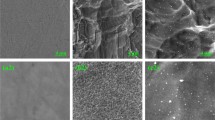Abstract
Titanium (Ti) and its alloys are used extensively in implants due to their excellent biocompatibility and mechanical properties. However, Ti-based implant materials have specific complications associated with their applications, such as the loosening of implanted host interface owing to unsatisfactory cell adhesion and the susceptibility of the implants to bacterial infections. Hence, a surface that displays selective biointeractivity, i.e., enhancing beneficial host cell responses but inhibiting pathogenic microbial adhesion, would be highly desirable. This study aims to confer long-lasting antibacterial properties and good biocompatibility on Ti via the microarc oxidation technique. The biocompatibility of the Ti surface was evaluated by cytotoxicity test, and the bacteriostasis rate was evaluated by antibacterial efficacy. The results showed that the implant surface might be nontoxic to cell and its long-lasting antibacterial properties could be significantly improved. These results indicate that such microarc oxidation coatings are expected to have good potential in transcutaneous implant applications.




Similar content being viewed by others
References
Leonhardt, A, Dahlén, G, “Effect of Titanium on Selected Oral Bacterial Species In Vitro.” Eur. J. Oral Sci., 103 382–387 (1995)
Yoshinari, M, Oda, Y, Kato, T, Okuda, K, Hirayama, A, “Influence of Surface Modifications to Titanium on Oral Bacterial Adhesion In Vitro.” J. Biomed. Mater. Res., 2 388–394 (2000)
Hetrick, EM, Schoenfisch, MH, “Reducing Implant-Related Infections: Active Release Strategies.” Chem. Soc. Rev., 35 780–789 (2006)
Velten, D, Biehl, V, Aubertin, F, Valeske, B, Possart, W, Breme, J, “Preparation of TiO2 Layers on cp-Ti and Ti6Al4V by Thermal and Anodic Oxidation and by Sol-Gel Coating Techniques and Their Characterization.” J. Biomed. Mater. Res., 59 18–28 (2002)
Panjian, L, Kangasniemi, I, De, GK, Kokubo, T, “Bonelike Hydroxyapatite Induction by a Gel-Derived Titania on a Titanium Substrate.” J. Am. Ceram. Soc., 77 1307–1312 (1994)
Wu, KR, Ting, CH, Liu, WC, Lin, CH, Wu, JK, “Successive Deposition of Layered Titanium Oxide/Indium Tin Oxide Films on Unheated Substrates by Twin Direct Current Magnetron Sputtering.” Thin Solid Films, 500 110–116 (2006)
Yang, B, Uchida, M, Kim, HM, Zhang, X, Kokubo, T, “Preparation of Bioactive Titanium Metal via Anodic Oxidation Treatment.” Biomaterials, 25 1003–1010 (2004)
Young, TS, Carina, J, Eungsun, B, Tomas, A, “The Bone Response of Oxidized Bioactive and Non-Bioactive Titanium Implants.” Biomaterials, 26 (33) 6720–6730 (2005)
Krysmann, W, Kruze, P, Diltrich, KH, Schneider, HG, “Process Characteristics and Parameters of Anodic Oxidation by Spark Discharge (ANOF).” Cryst. Res. Technol., 19 (7) 973–979 (1984)
Butyagin, PI, Khokhryakov, YeV, Mamaev, AI, “Microplasma Systems for Creating Coatings on Aluminium Alloys.” Mater. Lett., 57 1748–1750 (2003)
Yerokhin, AL, Voevodin, AA, Lyubimov, VV, et al., “Plasma Electrolytic Fabrication of Oxide Ceramic Surface Layers for Tribotechnical Purposes on Aluminium Alloys.” Surf. Coat. Technol., 110 140–146 (1998)
Yang, GL, Lu, XY, Bai, YZ, et al., “The Effects of Current Density on the Phase Composition and Microstructure Properties of Micro-Arc Oxidation Coating.” J. Alloys Compd., 345 196–200 (2002)
Shi, ZL, Neoh, KG, Kang, ET, Wang, W, “Antibacterial and Mechanical Properties of Bone Cement Impregnated with Chitosan Nanoparticles.” Biomaterials, 27 2440–2449 (2006)
Del Curto, B, Brunella, M, Giordano, C, et al., “Decreased Bacterial Adhesion to Surface-Treated Titanium.” Int. J. Artif. Organs, 28 (7) 718–730 (2005)
Shibata, Y, Kawai, H, Yamamoto, H, Igarashil, T, Miyazaki, T, “Antibacterial Titanium Plate Anodized by being Discharged in NaCl Solution Exhibits Cell Compatibility.” J. Dent. Res., 83 (2) 115–119 (2004)
Li, XJ, Cheng, GA, Xue, WB, Zheng, RT, Chen, YJ, “Wear and Corrosion Resistant Coatings Formed by Micro-Arc Oxidation on TiAl Alloy.” Mater. Chem. Phys., 107 148–152 (2008)
Acknowledgments
This work was supported by the State Key Program of National Natural Science of China; grant number: 30630066. The authors gratefully thank the State Key Laboratory for Mechanical Behavior of Materials at Xi’an Jiaotong University and Tissue Engineering Center (Fourth Military Medical University) in China for the research support.
Author information
Authors and Affiliations
Corresponding author
Rights and permissions
About this article
Cite this article
Li, J., Zhao, Y. Biocompatibility and antibacterial performance of titanium by surface treatment. J Coat Technol Res 9, 223–228 (2012). https://doi.org/10.1007/s11998-009-9221-1
Published:
Issue Date:
DOI: https://doi.org/10.1007/s11998-009-9221-1




